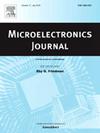A deep oxide trench SOI-LIGBT with self-driving PMOS for improved reliability
IF 1.9
3区 工程技术
Q3 ENGINEERING, ELECTRICAL & ELECTRONIC
引用次数: 0
Abstract
A novel SOI-LIGBT integrating Self-driving PMOS (SDP) is proposed. The SDP is introduced at the Emitter side which is consists of Deep Oxide Trench (DOT) and lowly Doped P-buried (DP). For the SDP, the Auxiliary Gate (AG) which is shortly connected with the Emitter acts as the gate, and the lowly Doped P-buried (DP), N-drift and P-well act as the source, substrate and drain, respectively. The SDP is designed without additional circuit control, moreover the SDP is driven adaptively along with the working mode of the LIGBT. At the forward conduction, the SDP with VGS > Vth is turned off and SDP is gradually turned on along with the increasing VCE, the N-drift substrate of the SDP creates an electrical channel for hole carriers to let the hole currents divert. At the turning off, the SDP with VGS < Vth is turned on again to extract the excessive hole carriers. Hence, the PDP-LIGBT achieves superior short reliability. As a result, the short circuit tolerance time of PDP-LIGBT reaches to 6.98 μs, and the EOFF is decreased by 18.5 % and 22.2 % under the same VON of 1.22 V when compared with the DOT-LIGBT, and DP-LIGBT.
求助全文
约1分钟内获得全文
求助全文
来源期刊

Microelectronics Journal
工程技术-工程:电子与电气
CiteScore
4.00
自引率
27.30%
发文量
222
审稿时长
43 days
期刊介绍:
Published since 1969, the Microelectronics Journal is an international forum for the dissemination of research and applications of microelectronic systems, circuits, and emerging technologies. Papers published in the Microelectronics Journal have undergone peer review to ensure originality, relevance, and timeliness. The journal thus provides a worldwide, regular, and comprehensive update on microelectronic circuits and systems.
The Microelectronics Journal invites papers describing significant research and applications in all of the areas listed below. Comprehensive review/survey papers covering recent developments will also be considered. The Microelectronics Journal covers circuits and systems. This topic includes but is not limited to: Analog, digital, mixed, and RF circuits and related design methodologies; Logic, architectural, and system level synthesis; Testing, design for testability, built-in self-test; Area, power, and thermal analysis and design; Mixed-domain simulation and design; Embedded systems; Non-von Neumann computing and related technologies and circuits; Design and test of high complexity systems integration; SoC, NoC, SIP, and NIP design and test; 3-D integration design and analysis; Emerging device technologies and circuits, such as FinFETs, SETs, spintronics, SFQ, MTJ, etc.
Application aspects such as signal and image processing including circuits for cryptography, sensors, and actuators including sensor networks, reliability and quality issues, and economic models are also welcome.
 求助内容:
求助内容: 应助结果提醒方式:
应助结果提醒方式:


